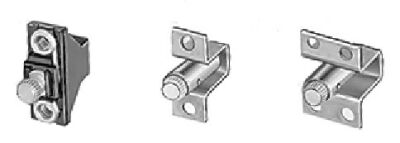Overload Relays & Heater Elements
Heater Elements
A thermal overload relay offers overcurrent protection for a large electric motor by acting as a mimic of the heat characteristics of the particular motor it’s protecting. Typically, the manufacturer uses a bimetallic plate near a heating element. The load current passes through the plate if an excessive current occurs. This process causes a closed contact to open and interrupts the flow of power to the contactor’s control circuit. The overload heater protects the motor, motor branch and circuit components from exposure to dangerous heat levels.
It is essential for safety and regulatory compliance to safeguard motors with overload heaters. A study from the Electrical Research Associates (ERA) of the United Kingdom in 1986 revealed that the leading cause of mechanical failures is overcurrent, which accounted for 30% of breakdowns in motors. This fact is important to consider since the modern world has more complex motors at work than ever before.
-
 Allen-Bradley
Allen-BradleyW80: Allen-Bradley NEMA Overload Relay Heater Element
- Model #:
- W80
- UPC #:
- 78118051296
- Part #:
- W80
- New/Surplus $ 28
- Refurb. Price $20 Save up to $ 8
- Repair Price $14 Save up to $ 14
-
 Allen-Bradley
Allen-BradleyW79: Allen-Bradley NEMA Overload Relay Heater Element
- Model #:
- W79
- UPC #:
- 78118051294
- Part #:
- W79
- New/Surplus $ 28
- Refurb. Price $20 Save up to $ 8
- Repair Price $14 Save up to $ 14
-
 Allen-Bradley
Allen-BradleyW78: Allen-Bradley NEMA Overload Relay Heater Element
- Model #:
- W78
- UPC #:
- 78118051293
- Part #:
- W78
- New/Surplus $ 28
- Refurb. Price $20 Save up to $ 8
- Repair Price $14 Save up to $ 14
-
 Allen-Bradley
Allen-BradleyW76: Allen-Bradley NEMA Overload Relay Heater Element
- Model #:
- W76
- UPC #:
- 78118051287
- Part #:
- W76
- New/Surplus $ 28
- Refurb. Price $20 Save up to $ 8
- Repair Price $14 Save up to $ 14
-
 Allen-Bradley
Allen-BradleyW77: Allen-Bradley NEMA Overload Relay Heater Element
- Model #:
- W77
- UPC #:
- 78118051289
- Part #:
- W77
- New/Surplus $ 28
- Refurb. Price $20 Save up to $ 8
- Repair Price $14 Save up to $ 14
-
 Allen-Bradley
Allen-BradleyW75: Allen-Bradley NEMA Overload Relay Heater Element
- Model #:
- W75
- UPC #:
- 78118051286
- Part #:
- W75
- New/Surplus $ 28
- Refurb. Price $20 Save up to $ 8
- Repair Price $14 Save up to $ 14
Types of Relays
There are two main certifying bodies for relays — the National Electrical Manufacturers Association (NEMA) and the International Electrotechnical Commission (IEC). There are three classes for overload relays, these being Class 10, Class 20 and Class 30. Each figure represents how many seconds it takes for the overload relay to respond to a problem.
The default for an unmarked relay is Class 20. The NEMA standard is typically Class 20, yet the guidelines allow for 15% above or below this figure. IEC relays are typically Class 10 but have more leeway, with a 50% allowance above or below the normal trip current.
It is important to note that it is always advisable to replace all three overload heaters in the event of an incident since the others are likely to fail within a reasonable time frame.
Overload Relay Specifications
There are several key specifications necessary to understand how to choose the correct overload relay:
- – Full load current: Every motor provides a rating plate with its full load current rating. The thermal overload relay must be set to the same value as the rating plate in order to trip the relay when overheating occurs.
- – Control voltage: The control voltage is typically less than the motor’s specified voltage because it is a separate control. This figure is one of the most important to consider when choosing an overload relay.
- – Pole: This term refers to how many distinct circuits that a switch controls. The number of switches also sets how many switch contacts are available, which in turn determines how many poles the overload relay would need to make or break the contacts. Each switch generally has one to four poles.
Repair or Replace Heater Elements With Global Electronic Services
Is your organization looking to repair damaged heater elements or find a reliable source of replacement components? Global Electronic Services has all-inclusive repair services and a broad variety of replacements above for your team to browse. Our technicians go through rigorous training and certification in the leading standards, including EASA, MIL-SPEC, ISCET and more.
Connect with one of our helpful representatives by phone at 877-249-1701 or contact us through our quick and convenient contact form online to receive a quote.
